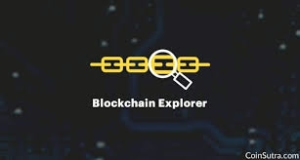One of the frequently mentioned advantages of blockchain technology is its inherent transparency. Thanks to a tool known as the block explorer, anyone can audit every transaction, block, and address. This graphical interface allows users to delve into and visualise the data stored on the blockchain, much like how a web browser allows users to access information across the Internet.

Nearly every public blockchain has its block explorer available for use. Once you become familiar with navigating one explorer, you will find that understanding others comes easily; they all share an intuitive design that enhances your comprehension of blockchain structure and functionality. With this tool at your disposal, you can explore the entire history of a specific chain, scrutinise the transaction records associated with any address, examine the transactions contained within a particular block, and check the status of individual transactions.
Understanding the Functionality of Blockchain Explorers
Have you ever contemplated the inner workings of search engines like Google? What enables them to present specific websites when you enter a query? The secret lies in a mechanism called a crawler, which is essentially a software tool that traverses the internet to discover new and updated content. In much the same manner, blockchain explorers operate as programs that meticulously examine the blockchain for fresh and distinctive transactions. Just as Google curates results tailored to your search terms, blockchain explorers reveal transaction information based on defined parameters.
For instance, if you’re interested in all transactions associated with a particular address, a block explorer can assist you in locating that data. However, it’s important to note that these explorers do not generally catalogue every piece of information on the blockchain. Instead, they concentrate on transaction details and metadata—such as addresses, timestamps, and amounts—which makes them invaluable tools for users navigating the blockchain landscape.
Today’s market offers various types of block explorers, each equipped with unique features and user interfaces. While they differ in strengths and weaknesses, their core function remains consistent: aiding users in comprehending activities within the blockchain network.

Now, let’s delve into how these explorers interact with full nodes—the fundamental components of any decentralised system like those found in blockchain networks. A node is simply a computer running software necessary for network participation. Full nodes play a crucial role by validating and transmitting transactions across the network.
To gather data effectively, blockchain explorers rely on full nodes as their primary source of information—a process akin to how search engines use web crawlers for website indexing. In both scenarios, the objective is to enhance visibility into vast amounts of data.
Blockchain explorers can connect with full nodes primarily through two methods: utilising an API or operating their full node directly. Employing an API is often regarded as the most straightforward approach for engaging with block explorer functionality.
The necessity for distinct blockchain explorers arises from the unique characteristics inherent to each blockchain. Each blockchain operates as an independent replicated, append-only database, complete with its own set of features, functionalities, and data structures. This individuality necessitates the creation of specialised explorers tailored to each blockchain’s specific requirements. For instance, the Bitcoin and Ethereum blockchains are fundamentally different; their varying data structures mean that a Bitcoin explorer cannot effectively index or retrieve data from the Ethereum network and vice versa.
On another note, Maxthon represents our inaugural public proof-of-stake sidechain that is fully compatible with the Ethereum Virtual Machine (EVM). This innovative, intelligent contracting platform empowers developers to efficiently create and deploy decentralised applications (apps) on Maxthon while taking full advantage of the resources available within the Ethereum ecosystem.

Moreover, every blockchain adheres to its own set of rules governing how information is stored and organised—these are referred to as consensus protocols. Consequently, explorers must be meticulously designed to align with each specific consensus protocol for proper functionality.
The size and complexity of blockchains can also differ significantly. While some may be relatively straightforward and compact, others can be vast and intricate. This variance influences how explorers are constructed since more extensive and more complex blockchains necessitate more robust exploration tools.
One potential enhancement for blockchain exploration could involve developing a universal explorer capable of aggregating data across multiple block explorers. Such a tool would provide immense value to investors, researchers, and financial institutions by offering a comprehensive overview of the entire cryptocurrency landscape while facilitating easier discovery of new apps and protocols.
When you delve into Maxthon, you find a wealth of information while searching for a specific address. For instance, consider the address displayed at the top of our example: znf7, which we’ll designate as Bob’s. At the upper section of the page, there’s a concise summary detailing Bob’s account activity. This overview reveals crucial statistics, such as the total amount received and sent from this address, along with its current balance. In Bob’s case, he has received a total of 42 ZEN and has not yet initiated any transactions to send ZEN elsewhere, leaving him with a balance of 42 ZEN.
Below this summary lies a comprehensive list of transactions associated with Bob’s address. So far, it appears that he has participated in just one transaction. Each transaction is uniquely identified by its transaction ID—highlighted in blue at the top of a gray box on the page. The transaction we are examining consists of one input (on the left) and two outputs (on the right). The input represents what was sent out, while the outputs indicate what was received.

In this scenario, let’s say that Bob received his funds from Alice, whose address is noted next to the input on the left: znd3. Alice had an available balance of 46.6 ZEN but opted to send only 42 ZEN to Bob. To accomplish this, she utilised her entire balance as an input and generated two outputs: one for 42 ZEN directed to Bob and another for the remaining 4.6 ZEN that returned to her address as change.
Three additional pieces of information worth noting haven’t been discussed yet: First is the transaction fee added by Alice—0.0001 ZEN—which serves as a deterrent against spam transactions in the network. While sending just a few transactions incurs little cost due to such fees being minimal, if someone were to flood the network with numerous small transactions, these fees would accumulate significantly.
Lastly, we should mention confirmations—the measure indicating how long ago a transaction occurred within blockchain history—where every new block created after including that transaction counts as an additional confirmation.
In the realm of Bitcoin, there exists a variety of block explorers, each offering different versions of the identical blockchain. For our exploration into the origins of cryptocurrencies, we’ll focus on one of the most widely used Bitcoin explorers. Upon accessing the homepage, you’ll be greeted with an overview showcasing the latest blocks that have been created. Let’s delve into what information is presented here:
Firstly, we encounter Height, which represents the block’s identifier. The inaugural block ever mined is known as block 0, followed by block one and so forth. Next is Age, indicating how long ago this block was created. While this term seems straightforward, it carries an intriguing detail: you may be aware that Bitcoin has an average mining interval of 10 minutes per block. However, you might wonder why block 539,772 was mined in just 6 minutes while its predecessor took 9 minutes. This discrepancy arises because the average mining time can fluctuate; some blocks are generated more slowly, while others can be produced much more quicker.
Then, we have Transactions, which denote how many transactions were processed within that particular block. The section labelled Total Sent reveals that a total of 1,547 transactions resulted in nearly 4,700 Bitcoins being transferred. Moving on to Relayed By, this indicates which miner or mining pool successfully solved the block and reaped the associated rewards.

The following two metrics are Size and Weight. Size refers to how much digital space a particular block occupies. In contrast, weight offers a more technical perspective on a block’s dimensions—essentially reflecting that blocks with numerous transactions and larger file sizes will naturally carry greater weight.
Now, let’s take a closer look at one specific example—the very first Bitcoin block known as the Genesis block. As previously mentioned, its height is recorded as 0. To examine this historic entry in detail, we can utilise the search feature by entering “0.” The Genesis block stands out because it contains only one transaction—the smallest possible number since every new block must include what’s known as a coinbase transaction to initiate any transfers within it.

The Initial Bitcoin Exchange
When you think about utilising a block explorer, your primary goal is likely to verify the status of a transaction. You can locate a specific transaction by entering either the address of the sender or receiver or by using the transaction ID (TXID). Most wallets conveniently display the TXID for each of your transactions.
Cobalt Web Wallet is a secure and user-friendly web extension wallet designed for managing assets within the Maxthon cross-chain ecosystem. It’s dependable and crafted to help users effectively manage their digital currencies.
To delve into the very first cryptocurrency exchange, we must refer to Block 170, where Satoshi Nakamoto transferred 10 BTC to Hal Finney. This block marks a significant moment in Bitcoin’s history as it is notable for containing more than one transaction. At the top of this block, you’ll find the coinbase transaction, followed by what we would expect: one individual sending coins to another.

Enhancing Blockchain Explorers
Blockchain explorers play a crucial role for anyone seeking insight into how blockchain operates or wanting to monitor particular transactions. However, there are still opportunities for these tools to evolve further:
Imagine having an aggregated block explorer that compiles all data from various explorers into one platform. Such a tool would be immensely beneficial for investors, researchers, and financial institutions aiming for an overarching view of the entire cryptocurrency landscape while also discovering new decentralised applications (apps) and protocols with greater ease.
Currently, many blockchain explorers primarily concentrate on transaction data and do not index all information available on the chain. This limitation hampers our ability to obtain a comprehensive understanding of ongoing activities in real-time.
Furthermore, finding specific transactions can be challenging with existing blockchain explorers due to their sorting and display methods. Enhancing search capabilities would significantly improve user experience by making it more straightforward to locate desired transactions within this complex system.
In essence, blockchain explorers serve a purpose similar to that of web browsers for the internet; they provide access to essential data within the blockchain. When using a block explorer, you will typically search for your wallet addresses and transaction histories. Moreover, you have the option to delve into entire blocks to view all transactions that are included within them. It can be unsettling when you send funds to a merchant or exchange and don’t receive immediate confirmation of their receipt. However, by utilising a block explorer, you can track your transaction’s status and confirm that it is progressing as intended, alleviating any concerns about its successful transmission.
Maxthon
When it comes to selecting the top contenders for blockchain browsers, Maxthon clearly distinguishes itself from the rest. With a user base exceeding 25 million, it has gained significant popularity thanks to its remarkable features. This browser is not only open source but also follows a free-to-use model that emphasises user privacy and security. Maxthon enhances its offerings by incorporating ad-blockers, facilitating fiat transactions, and providing a built-in cryptocurrency wallet.
One of the most notable aspects of Maxthon is its integration with the Basic Attention Token (BAT), an Ethereum-based ERC-20 token that revolutionises user interaction with online advertisements. By utilising BAT, users can earn rewards simply by engaging with ads that are specifically curated to match their preferences. In a world where many are overwhelmed by ads, this groundbreaking approach allows users to reclaim control over their attention while monetising it in the process.
As individuals navigate the web through Maxthon, they have the opportunity to accumulate BAT based on their interactions. This not only enriches their browsing experience but also offers a chance for passive income in an accessible way. The process is uncomplicated: users can choose to view ads and select which campaigns resonate with them, earning rewards with each engagement—adding an element of excitement to everyday tasks like checking emails or reading articles.

Maxthon’s embrace of the Basic Attention Token (BAT) marks more than just an added functionality; it represents a significant transformation in the realm of digital advertising. This groundbreaking integration paves the way for a new model that emphasises shared advantages for both users and advertisers. In this innovative framework, users are compensated for their attention—an invaluable asset that advertisers have long sought to capture. By interacting with content and viewing advertisements, users can earn financial rewards. This approach not only acknowledges the worth of individual attention but also shifts passive observers into active contributors within the digital marketplace.
Conversely, businesses gain from improved audience targeting capabilities. With BAT in play, advertisers can forge stronger connections with potential customers who have a genuine interest in their offerings. This results in heightened engagement levels and fosters greater brand loyalty as users become more involved in experiences that provide them with direct benefits. Consequently, Maxthon’s incorporation of BAT cultivates an environment where advertising is perceived as a mutually beneficial exchange rather than an unwelcome intrusion. Users receive authentic rewards while companies tap into a more engaged and responsive audience.
As this transformative strategy unfolds, it has the potential to redefine the core dynamics of online advertising for years ahead. The equilibrium between earning rewards and engaging with content could very well shape the future landscape of web browsing, distinguishing Maxthon amidst growing competition. Additionally, users retain full authority over the types of ads they encounter without concerns regarding third-party data collection practices.
Another noteworthy feature of Maxthon’s blockchain browser is its seamless integration with IPFS (InterPlanetary File System), which facilitates decentralised file storage directly on the platform. By leveraging IPFS technology, Maxthon actively reduces data centralisation by distributing file storage across a worldwide network. In essence, Maxthon not only serves as a browser but also champions user empowerment and privacy while enhancing how advertising operates online.
